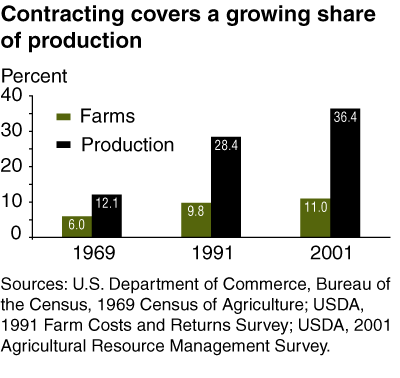Contract Use Continues to Expand
- by James M. MacDonald and Janet Perry
- 11/1/2004
The desire for specific attributes in agricultural products is making contracts the method of choice for moving products through the production and marketing system. These attributes cover everything from oil content in corn, which affects feed digestion, to the weight of market hogs, because uniform weights can reduce processing costs. Other examples include milk produced according to organic standards, or attributes tied to a product’s delivery, such as a certain volume of peas provided during a specified time window, that can reduce processing costs and better meet consumer demands.
Buyers—processors, elevators, and retailers—use production contracts to control input choices and production methods. They also use marketing contracts that offer farmers price premiums for desired attributes. Farmers can benefit from contracting as well, in that contracts can reduce income risks, ease credit requirements, and provide higher prices for providing specific product attributes.
But there are downsides to contracting. Specific features of contracts, like requiring use of a specific feed ration, can limit farmers’ decisionmaking freedom. Contracts can reduce volumes traded on spot markets (where individual buyers and sellers agree to a price at the time the product changes hands), thereby increasing price volatility and risks of trading in spot markets. They can also be structured to limit competition among buyers.
An observed expansion in contract use is closely tied to consolidation in agriculture. Among farms with at least $500,000 in annual sales, 61 percent used contracts for at least some of their production in 2001, compared with only 8 percent of farms with sales under $250,000. Because most farms are small, only 11 percent of all farms used contracts in 2001, up from 6 percent in 1969. But because large farms account for most agricultural production, contracts cover a large and growing share of production—36 percent in 2001, up from 12 percent in 1969 and 28 percent in 1991.
The use of contracts can spread rapidly through an industry. Virtually nonexistent in tobacco marketing in 1999, contracts covered half of 2001 production and almost 100 percent of 2002 production. In just 5 years, from 1996 to 2001, contract coverage grew from one-third to two-thirds of hog production, as spot markets commensurately diminished. By 2001, contracts covered 54 percent of cotton and 39 percent of rice production, compared with 30 percent and 20 percent, respectively, in 1991.
Growing demand for specific product attributes should lead to continuing expansion of contracting. In turn, spot markets will come under continuing pressure to adapt to the challenge posed by the contracting alternative, by providing better means of defining, measuring, and communicating product attributes.
This article is drawn from:
- Farm Structure and Organization. (n.d.). U.S. Department of Agriculture, Economic Research Service.
- MacDonald, J.M., Perry, J., Ahearn, M., Banker, D.E., Chambers, W., Dimitri, C., Key, N. & Nelson, K. (2004). Contracts, Markets, and Prices: Organizing the Production and Use of Agricultural Commodities. U.S. Department of Agriculture, Economic Research Service. AER-837.


